Monoblock vs. modular UPS
A brief educational program for beginners about why modular UPSs are cooler and how it happened.
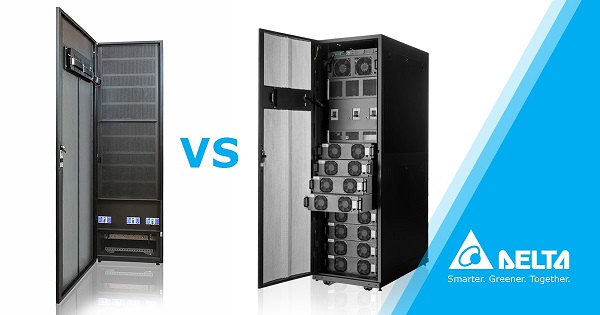
Uninterruptible power supplies for data centers on the construction architecture are divided into two large groups: monoblock and modular. The first belong to the traditional type of UPS, the second are relatively new and more advanced.
What is the difference between monoblock and modular UPS?
In monoblock uninterruptible power supplies, the output power is provided by a single power unit. In modular UPSs, the main components are made up of separate modules that are housed in standardized cabinets and work together. Each of these modules is equipped with a control processor, charger, inverter, rectifier and is a complete power part of the UPS.
Let us explain this with a simple example. If you take two uninterruptible power supplies - monoblock and modular - with a capacity of 40 kVA, then the first will have one power module with a capacity of 40 kVA, and the second will consist, for example, of four power modules with a capacity of 10 kVA each.
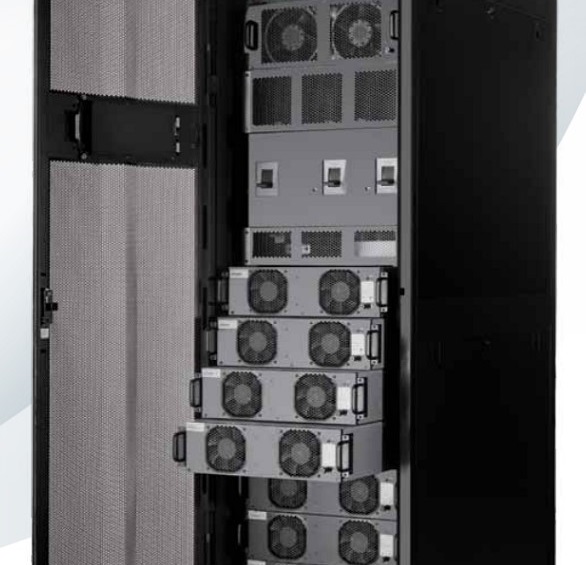
Scaling options
When using monoblock UPS with an increase in the need for power supply, it is necessary to connect in parallel to the existing one more full-power unit of the same capacity. This is a rather complicated process.
Modular solutions are more constructive flexibility. In this case, one or more modules can be connected to an already functioning unit. This is a fairly simple procedure that can be performed in a short time.
')
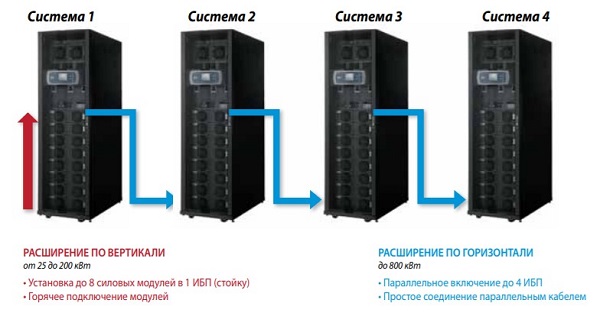
Opportunities for smooth capacity expansion
Smooth power expansion is important at the initial stage of data center operation. It is quite logical that in the first months it will be loaded at 30–40%. It is more practical and economical to use uninterruptible power supplies designed specifically for this power. As the customer base is replenished, the data center load will increase, and with it the need for additional power supply will increase.
Power UPS is convenient to increase in stages along with the technical infrastructure. When using monoblock uninterruptible power supplies, smooth capacity expansion is impossible in principle. With modular UPSs, it is easy to implement.
UPS Reliability
Speaking of reliability, we will operate with two concepts: mean time between failures (MTBF) and mean system recovery time (MTTR).
MTBF is a probabilistic value. The mean time between failures is based on the following postulate: the reliability of the system decreases with an increase in the number of its components.
In this parameter, the advantage of monoblock UPS. The reason is simple: in modular uninterruptible power supplies more structural elements and detachable connections, each of which is considered as a potential point of failure. Accordingly, in theory, the possibility of failure is higher here.
However, for uninterruptible power supplies used in the data center, it is not the fault itself that is important, but how long the UPS will remain out of service. This parameter is determined by the average system recovery time (MTTR).
Here the advantage is already on the side of modular units. They have a low MTTR value, because any module can be quickly replaced without interruption in power supply. For this, it is necessary that this module be in stock, and one specialist is able to perform its dismantling and installation. In fact, it takes no more than 30 minutes.
With monoblock uninterruptible power supplies, the situation is much more complicated. Their repair to perform so quickly fail. It can take from several hours to several days.
To determine the fault tolerance of the system, you can use another parameter - availability or otherwise working capacity. This indicator is higher, the longer the mean time between failures (MTBF) and the shorter the mean system recovery time (MTTR). The corresponding formula is as follows:
average availability (availability) = 
With regard to modular UPSs, the situation is as follows: their MTBF value is lower than that of the monoblock UPS, but at the same time they have a significantly lower MTTR. As a result, the performance of modular uninterruptible power supplies is higher.
power usage
Monoblock system requires much more energy, because it is redundant. Let us explain this with an example for the redundancy scheme N + 1. N is the amount of load required to operate the data center equipment. In our case, we will take it equal to 90 kVA. The scheme N + 1 means that 1 backup element remains unused in the system before the failure.
When using a monoblock uninterruptible power supply with a capacity of 90 kVA to implement the N + 1 scheme, it will be necessary to use one more such unit. As a result, the total system redundancy will be 90 kVA.
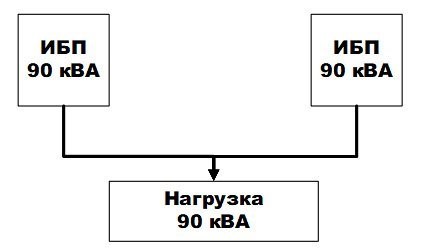
When using modular UPS with a capacity of 30 kVA, the situation is different. With the same load, for implementation of the N + 1 scheme, one more such module will be needed. As a result, the overall system redundancy will no longer be 90 kVA, but only 30 kVA.
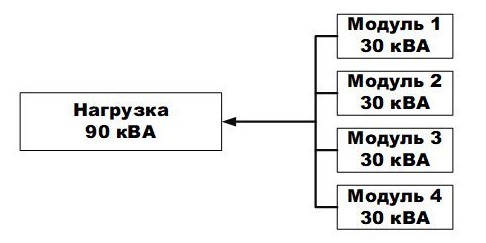
Hence the conclusion: the use of modular power supplies can reduce the energy consumption of the data center as a whole.
Economy
If you take two uninterruptible power supplies of the same power, then monoblock is cheaper than modular. For this reason, all-in-one UPSs remain popular. However, an increase in output power will double the cost of the system, because one more unit will have to be added to the existing one. In addition, it will be necessary to install switching panels and switchboards, as well as laying new cable lines.
When using modular uninterruptible power supplies, the system capacity can be increased smoothly. So it will have to spend money on the purchase of such a number of modules, which are enough to meet the existing power supply needs. Without unnecessary stock.
Conclusion
Monoblock uninterruptible power supplies are low cost, easy to set up and operate. At the same time, they increase the energy consumption of the data center and are difficult to scale. Such systems are convenient and effective where small capacities are required and their expansion is not supposed.
Modular UPSs are characterized by easy scalability, minimal recovery time, high reliability and availability. Such systems are optimal for increasing the power of the data center to any limits with minimal cost.
Source: https://habr.com/ru/post/445684/
All Articles